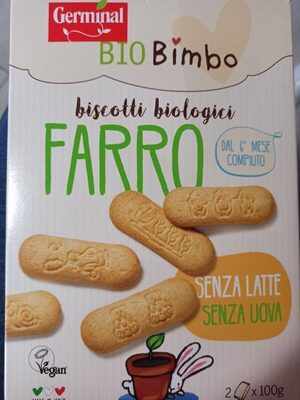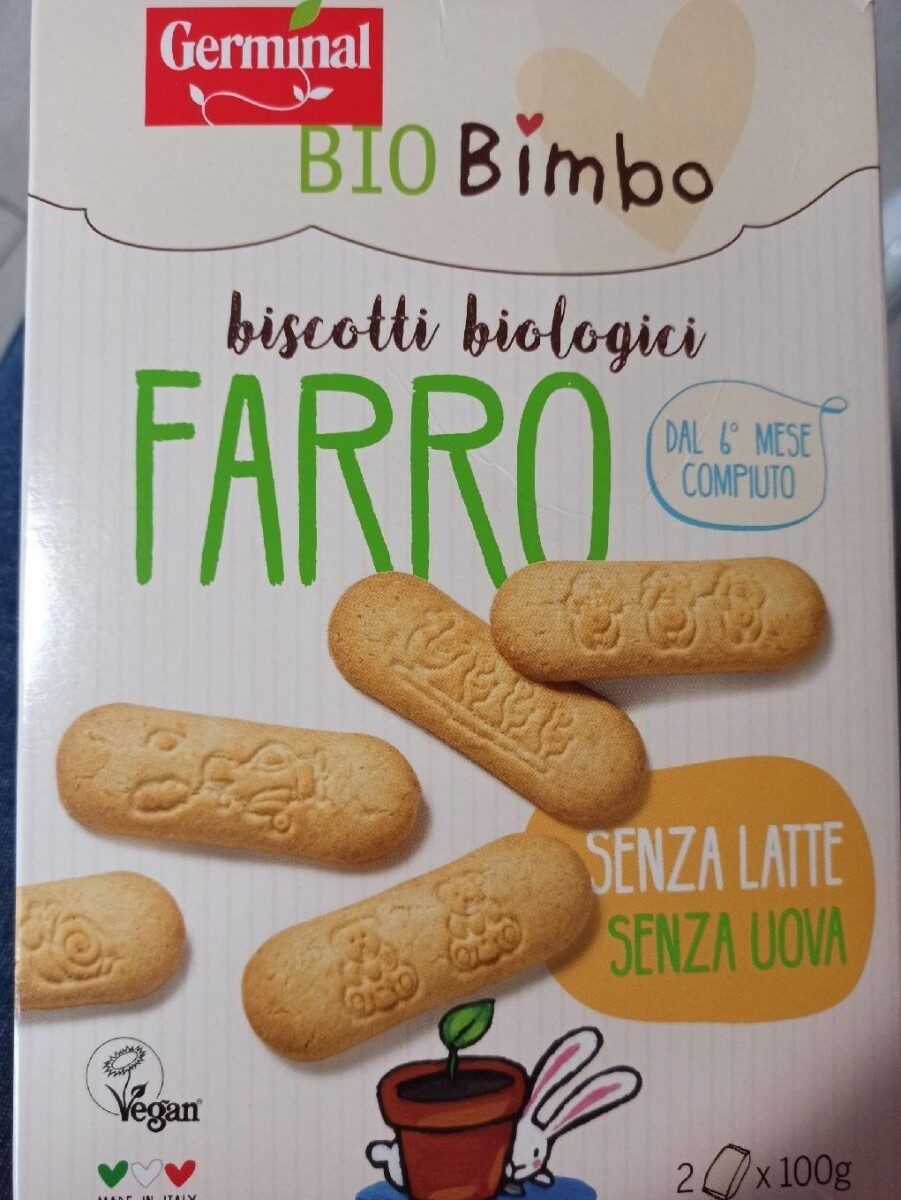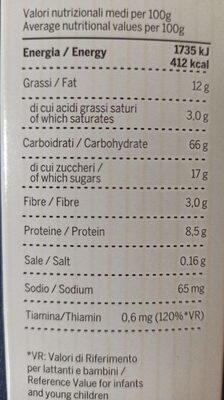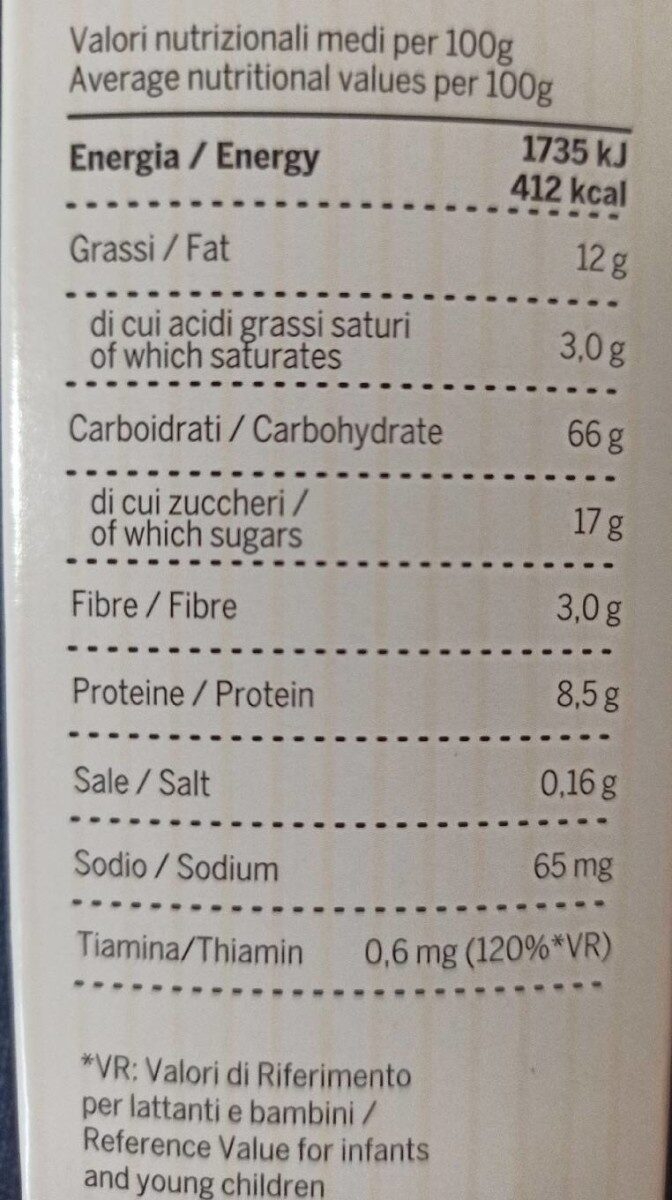Help us make food transparency the norm!
As a non-profit organization, we depend on your donations to continue informing consumers around the world about what they eat.
The food revolution starts with you!
Biscotti biologici di farro - Bio Bimbo - 200 g
Biscotti biologici di farro - Bio Bimbo - 200 g
This product page is not complete. You can help to complete it by editing it and adding more data from the photos we have, or by taking more photos using the app for Android or iPhone/iPad. Thank you!
×
Barcode: 8005647005212 (EAN / EAN-13)
Common name: Biscotti per la prima infanzia
Quantity: 200 g
Categories: Snacks, Sweet snacks, Biscuits and cakes, Farming products, Biscuits, Eggs
Labels, certifications, awards:
Organic, Vegetarian, Vegan, No eggs, No milk, The Vegan Society
Origin of ingredients: Italy
Manufacturing or processing places: Italia
Countries where sold: Italy
Matching with your preferences
Health
Ingredients
-
18 ingredients
: Farina di farro 48%, zucchero d'uva 12%, farina di riso, zucchero di canna, amido di riso, olio extravergine d'oliva 7%, olio di girasole, agenti lievitanti (carbonati di ammonio, tartrati di potassio, carbonati di sodio), addensante: gomma arabica, riso germogliato, aroma naturale, lattato di calcio, tiamina (vitamina B1).Allergens: Gluten
Food processing
-
Ultra processed foods
Elements that indicate the product is in the 4 - Ultra processed food and drink products group:
- Additive: E327 - Calcium lactate
- Additive: E414 - Acacia gum
- Ingredient: Flavouring
- Ingredient: Thickener
Food products are classified into 4 groups according to their degree of processing:
- Unprocessed or minimally processed foods
- Processed culinary ingredients
- Processed foods
- Ultra processed foods
The determination of the group is based on the category of the product and on the ingredients it contains.
Additives
-
E327 - Calcium lactate
Calcium lactate: Calcium lactate is a white crystalline salt with formula C6H10CaO6, consisting of two lactate anions H3C-CHOH-CO−2 for each calcium cation Ca2+. It forms several hydrates, the most common being the pentahydrate C6H10CaO6·5H2O. Calcium lactate is used in medicine, mainly to treat calcium deficiencies; and as a food additive with E number of E327. Some cheese crystals consist of calcium lactate.Source: Wikipedia
-
E336 - Potassium tartrates
Potassium tartrate: Potassium tartrate, dipotassium tartrate or argol has formula K2C4H4O6. It is the potassium salt of tartaric acid. It is often confused with potassium bitartrate, also known as cream of tartar. As a food additive, it shares the E number E336 with potassium bitartrate.Source: Wikipedia
-
E414 - Acacia gum
Gum arabic: Gum arabic, also known as acacia gum, arabic gum, gum acacia, acacia, Senegal gum and Indian gum, and by other names, is a natural gum consisting of the hardened sap of various species of the acacia tree. Originally, gum arabic was collected from Acacia nilotica which was called the "gum arabic tree"; in the present day, gum arabic is collected from acacia species, predominantly Acacia senegal and Vachellia -Acacia- seyal; the term "gum arabic" does not indicate a particular botanical source. In a few cases so‐called "gum arabic" may not even have been collected from Acacia species, but may originate from Combretum, Albizia or some other genus. Producers harvest the gum commercially from wild trees, mostly in Sudan -80%- and throughout the Sahel, from Senegal to Somalia—though it is historically cultivated in Arabia and West Asia. Gum arabic is a complex mixture of glycoproteins and polysaccharides. It is the original source of the sugars arabinose and ribose, both of which were first discovered and isolated from it, and are named after it. Gum arabic is soluble in water. It is edible, and used primarily in the food industry as a stabilizer, with EU E number E414. Gum arabic is a key ingredient in traditional lithography and is used in printing, paint production, glue, cosmetics and various industrial applications, including viscosity control in inks and in textile industries, though less expensive materials compete with it for many of these roles. While gum arabic is now produced throughout the African Sahel, it is still harvested and used in the Middle East.Source: Wikipedia
-
E500 - Sodium carbonates
Sodium carbonates (E500) are compounds commonly used in food preparation as leavening agents, helping baked goods rise by releasing carbon dioxide when they interact with acids.
Often found in baking soda, they regulate the pH of food, preventing it from becoming too acidic or too alkaline. In the culinary world, sodium carbonates can also enhance the texture and structure of foods, such as noodles, by modifying the gluten network.
Generally recognized as safe, sodium carbonates are non-toxic when consumed in typical amounts found in food.
-
E503 - Ammonium carbonates
Ammonium carbonate: Ammonium carbonate is a salt with the chemical formula -NH4-2CO3. Since it readily degrades to gaseous ammonia and carbon dioxide upon heating, it is used as a leavening agent and also as smelling salt. It is also known as baker's ammonia and was a predecessor to the more modern leavening agents baking soda and baking powder. It is a component of what was formerly known as sal volatile and salt of hartshorn.Source: Wikipedia
Ingredients analysis
-
Palm oil free
No ingredients containing palm oil detected
Unrecognized ingredients: it:riso-germogliatoSome ingredients could not be recognized.
We need your help!
You can help us recognize more ingredients and better analyze the list of ingredients for this product and others:
- Edit this product page to correct spelling mistakes in the ingredients list, and/or to remove ingredients in other languages and sentences that are not related to the ingredients.
- Add new entries, synonyms or translations to our multilingual lists of ingredients, ingredient processing methods, and labels.
If you would like to help, join the #ingredients channel on our Slack discussion space and/or learn about ingredients analysis on our wiki. Thank you!
-
Vegan
No non-vegan ingredients
Unrecognized ingredients: Grape sugar, it:riso-germogliato, Thiamin, ThiaminSome ingredients could not be recognized.
We need your help!
You can help us recognize more ingredients and better analyze the list of ingredients for this product and others:
- Edit this product page to correct spelling mistakes in the ingredients list, and/or to remove ingredients in other languages and sentences that are not related to the ingredients.
- Add new entries, synonyms or translations to our multilingual lists of ingredients, ingredient processing methods, and labels.
If you would like to help, join the #ingredients channel on our Slack discussion space and/or learn about ingredients analysis on our wiki. Thank you!
-
Vegetarian
No non-vegetarian ingredients detected
Unrecognized ingredients: Grape sugar, it:riso-germogliato, Thiamin, ThiaminSome ingredients could not be recognized.
We need your help!
You can help us recognize more ingredients and better analyze the list of ingredients for this product and others:
- Edit this product page to correct spelling mistakes in the ingredients list, and/or to remove ingredients in other languages and sentences that are not related to the ingredients.
- Add new entries, synonyms or translations to our multilingual lists of ingredients, ingredient processing methods, and labels.
If you would like to help, join the #ingredients channel on our Slack discussion space and/or learn about ingredients analysis on our wiki. Thank you!
-
Details of the analysis of the ingredients
We need your help!
Some ingredients could not be recognized.
We need your help!
You can help us recognize more ingredients and better analyze the list of ingredients for this product and others:
- Edit this product page to correct spelling mistakes in the ingredients list, and/or to remove ingredients in other languages and sentences that are not related to the ingredients.
- Add new entries, synonyms or translations to our multilingual lists of ingredients, ingredient processing methods, and labels.
If you would like to help, join the #ingredients channel on our Slack discussion space and/or learn about ingredients analysis on our wiki. Thank you!
: Farina di _farro_ 48%, zucchero d'uva 12%, farina di riso, zucchero di canna, amido di riso, olio extravergine d'oliva 7%, olio di girasole, agenti lievitanti (carbonati di ammonio, tartrati di potassio, carbonati di sodio), addensante (gomma arabica), riso germogliato, aroma naturale, lattato di calcio, tiamina (vitamina B1)- Farina di _farro_ -> en:spelt-flour - vegan: yes - vegetarian: yes - ciqual_food_code: 9480 - percent_min: 48 - percent: 48 - percent_max: 48
- zucchero d'uva -> en:grape-sugar - percent_min: 12 - percent: 12 - percent_max: 12
- farina di riso -> en:rice-flour - vegan: yes - vegetarian: yes - ciqual_food_code: 9520 - percent_min: 7 - percent_max: 12
- zucchero di canna -> en:cane-sugar - vegan: yes - vegetarian: yes - ciqual_proxy_food_code: 31016 - percent_min: 7 - percent_max: 12
- amido di riso -> en:rice-starch - vegan: yes - vegetarian: yes - ciqual_proxy_food_code: 9510 - percent_min: 7 - percent_max: 11
- olio extravergine d'oliva -> en:extra-virgin-olive-oil - vegan: yes - vegetarian: yes - from_palm_oil: no - ciqual_food_code: 17270 - percent_min: 7 - percent: 7 - percent_max: 6.5
- olio di girasole -> en:sunflower-oil - vegan: yes - vegetarian: yes - from_palm_oil: no - ciqual_food_code: 17440 - percent_min: 0 - percent_max: 3.8
- agenti lievitanti -> en:raising-agent - percent_min: 0 - percent_max: 3.16666666666667
- carbonati di ammonio -> en:e503 - vegan: yes - vegetarian: yes - percent_min: 0 - percent_max: 3.16666666666667
- tartrati di potassio -> en:e336 - vegan: yes - vegetarian: yes - percent_min: 0 - percent_max: 1.58333333333333
- carbonati di sodio -> en:e500 - vegan: yes - vegetarian: yes - percent_min: 0 - percent_max: 1.05555555555556
- addensante -> en:thickener - percent_min: 0 - percent_max: 2.71428571428571
- gomma arabica -> en:e414 - vegan: yes - vegetarian: yes - percent_min: 0 - percent_max: 2.71428571428571
- riso germogliato -> it:riso-germogliato - percent_min: 0 - percent_max: 2.375
- aroma naturale -> en:natural-flavouring - vegan: maybe - vegetarian: maybe - percent_min: 0 - percent_max: 2.11111111111111
- lattato di calcio -> en:e327 - vegan: yes - vegetarian: yes - percent_min: 0 - percent_max: 1.9
- tiamina -> en:thiamin - percent_min: 0 - percent_max: 1.72727272727273
- vitamina B1 -> en:thiamin - percent_min: 0 - percent_max: 1.72727272727273
Nutrition
-
Good nutritional quality
⚠ ️Warning: the amount of fruits, vegetables and nuts is not specified on the label, it was estimated from the list of ingredients: 7This product is not considered a beverage for the calculation of the Nutri-Score.
Positive points: 8
- Proteins: 5 / 5 (value: 8.5, rounded value: 8.5)
- Fiber: 3 / 5 (value: 3, rounded value: 3)
- Fruits, vegetables, nuts, and colza/walnut/olive oils: 0 / 5 (value: 7, rounded value: 7)
Negative points: 10
- Energy: 5 / 10 (value: 1735, rounded value: 1735)
- Sugars: 3 / 10 (value: 17, rounded value: 17)
- Saturated fat: 2 / 10 (value: 3, rounded value: 3)
- Sodium: 0 / 10 (value: 65, rounded value: 65)
The points for proteins are counted because the negative points are less than 11.
Nutritional score: (10 - 8)
Nutri-Score:
-
Nutrient levels
-
Fat in moderate quantity (12%)
What you need to know- A high consumption of fat, especially saturated fats, can raise cholesterol, which increases the risk of heart diseases.
Recommendation: Limit the consumption of fat and saturated fat- Choose products with lower fat and saturated fat content.
-
Saturated fat in moderate quantity (3%)
What you need to know- A high consumption of fat, especially saturated fats, can raise cholesterol, which increases the risk of heart diseases.
Recommendation: Limit the consumption of fat and saturated fat- Choose products with lower fat and saturated fat content.
-
Sugars in high quantity (17%)
What you need to know- A high consumption of sugar can cause weight gain and tooth decay. It also augments the risk of type 2 diabetes and cardio-vascular diseases.
Recommendation: Limit the consumption of sugar and sugary drinks- Sugary drinks (such as sodas, fruit beverages, and fruit juices and nectars) should be limited as much as possible (no more than 1 glass a day).
- Choose products with lower sugar content and reduce the consumption of products with added sugars.
-
Salt in low quantity (0.163%)
What you need to know- A high consumption of salt (or sodium) can cause raised blood pressure, which can increase the risk of heart disease and stroke.
- Many people who have high blood pressure do not know it, as there are often no symptoms.
- Most people consume too much salt (on average 9 to 12 grams per day), around twice the recommended maximum level of intake.
Recommendation: Limit the consumption of salt and salted food- Reduce the quantity of salt used when cooking, and don't salt again at the table.
- Limit the consumption of salty snacks and choose products with lower salt content.
-
-
Nutrition facts
Nutrition facts As sold
for 100 g / 100 mlCompared to: Eggs Energy 1,735 kj
(412 kcal)+208% Fat 12 g +30% Saturated fat 3 g +11% Carbohydrates 66 g +12,400% Sugars 17 g +5,529% Fiber 3 g +7,900% Proteins 8.5 g -31% Salt 0.162 g -53% Vitamin B1 (Thiamin) 0.6 mg +40,996% Fruits‚ vegetables‚ nuts and rapeseed‚ walnut and olive oils (estimate from ingredients list analysis) 7 %
Environment
-
Eco-Score C - Moderate environmental impact
⚠ ️Select a country in order to include the full impact of transportation.The Eco-Score is an experimental score that summarizes the environmental impacts of food products.→ The Eco-Score was initially developped for France and it is being extended to other European countries. The Eco-Score formula is subject to change as it is regularly improved to make it more precise and better suited to each country.Life cycle analysis
-
Average impact of products of the same category: C (Score: 50/100)
Category: Egg, raw
Category: Egg, raw
- PEF environmental score: 0.55 (the lower the score, the lower the impact)
- including impact on climate change: 3.19 kg CO2 eq/kg of product
Stage Impact Agriculture
94.2 %Processing
0.0 %Packaging
2.3 %Transportation
2.5 %Distribution
0.4 %Consumption
0.6 %
Bonuses and maluses
-
Origins of ingredients with a medium impact
Bonus: +2
Environmental policy: +2
Transportation: 0
Origin of the product and/or its ingredients % of ingredients Impact Italy 100 %Medium
-
Packaging with a medium impact
Malus: -11
Shape Material Recycling Impact Unknown Plastic High Unknown Paper Low ⚠ ️ The information about the packaging of this product is not sufficiently precise (exact shapes and materials of all components of the packaging).⚠ ️ For a more precise calculation of the Eco-Score, you can modify the product page and add them.
If you are the manufacturer of this product, you can send us the information with our free platform for producers.
Eco-Score for this product
-
Impact for this product: C (Score: 41/100)
Product: Biscotti biologici di farro - Bio Bimbo - 200 g
Life cycle analysis score: 50
Sum of bonuses and maluses: -9
Final score: 41/100
-
Carbon footprint
-
Equal to driving 1.7 km in a petrol car
319 g CO² per 100g of product
The carbon emission figure comes from ADEME's Agribalyse database, for the category: Egg, raw (Source: ADEME Agribalyse Database)
Stage Impact Agriculture
88.0 %Processing
0.0 %Packaging
3.9 %Transportation
5.3 %Distribution
0.3 %Consumption
2.5 %
Packaging
-
Packaging with a medium impact
-
Packaging parts
(Plastic)
(Paper)
-
Packaging materials
Material % Packaging weight Packaging weight per 100 g of product Paper or cardboard Plastic Total
-
Transportation
-
Origins of ingredients
Origins of ingredients with a medium impact
Origin of the product and/or its ingredients % of ingredients Impact Italy 100 %Medium
Report a problem
-
Incomplete or incorrect information?
Category, labels, ingredients, allergens, nutritional information, photos etc.
If the information does not match the information on the packaging, please complete or correct it. Open Food Facts is a collaborative database, and every contribution is useful for all.
Data sources
Product added on by meyer
Last edit of product page on by charlesnepote.
Product page also edited by jpirson, kiliweb, packbot, roboto-app, teolemon, yuka.sY2b0xO6T85zoF3NwEKvlmlAa8uBhW38PhDVi1aTntC8cLq3TdRw4KLTHas.









